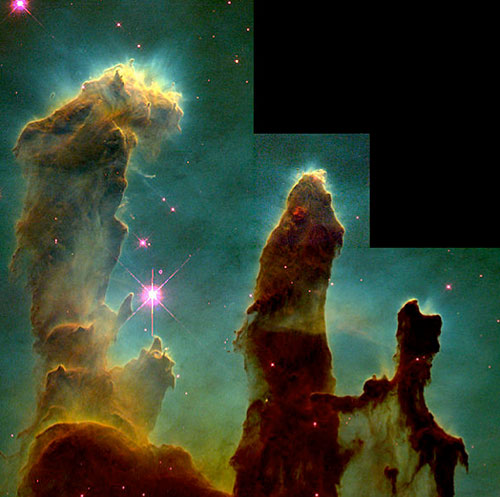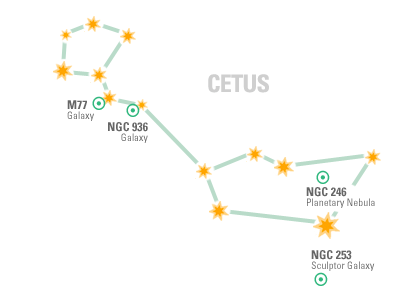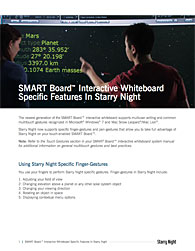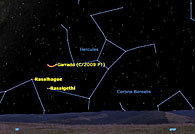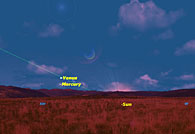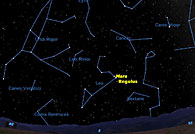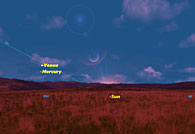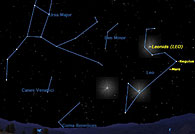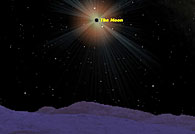 |
||||||||||||||||||||||||||||||||||||||||||||||||||||||||||||||||||||||||||||||||||||||||||||||||||||||||
For education orders please call 1-877-290-8256. Welcome again to our monthly newsletter with features on exciting celestial and earth science events, product reviews, tips & tricks, and a monthly sky calendar. We hope you enjoy it!
Jupiter is in opposition on October 29 at 2h UT, which converts to October 28 at 10 p.m. EDT. This means that Jupiter is exactly opposite the Sun in the sky, and that it is visible the entire night, rising as the Sun sets in the evening, and setting as the Sun rises in the morning. In even the smallest telescope, Jupiter’s four largest moons are easily visible. Their positions change from night to night, as Galileo noticed in 1609. Starry Night plots the moons’ positions accurately, allowing you to easily identify them. In the course of their travels around Jupiter, the moons frequently pass in front of or behind Jupiter. When the moons pass in front of the planet, they often disappear from sight, but cast their shadows on the disk. These shadows are visible in moderate sized telescopes (90mm aperture or greater). Although they are small in angular size, the shadows are very very dark, so are much easier to see than one would think. Sometimes two or even three shadows are visible simultaneously, but never four. The resonances between the orbits of Jupiter’s moons prevent that from ever happening. More than any other planet, Jupiter reveals more detail on its disk. At first this may seem strange, since Jupiter is a “gas giant” and so all we are observing are its cloud tops. But, because of its gigantic size, 11 times larger in diameter than Earth, and its rapid rotation, Jupiter has by far the most violent weather systems of any planet. The first thing anyone notices looking at Jupiter through a telescope is that its atmosphere is organized into horizontal stripes, known as belts (dark) and zones (light). The exact details vary from year to year, but usually there are two dark belts, the North Equatorial and South Equatorial Belts, on either side of a lighter Equatorial Zone. Often there are one or more dark belts located north or south of the two Equatorial Belts. The colors of the belts and zones are a result of their chemical composition, temperature, and altitude. This complex system is then smeared horizontally into stripes by Jupiter’s rapid rotation, averaging one rotation in less than ten hours on average. Because we are observing cloud tops rather than solid surface features, and these are subject to shearing wind forces, different features in Jupiter’s atmosphere have different rotation periods. To bring some order out of this apparent chaos, astronomers have designated certain reference systems of longitude, and assigned rotation periods to them. The three main rotation systems on Jupiter are called System I, System II, and System III. System I mainly refers to objects in the Equatorial Zone and the adjoining parts of the Equatorial Belts, and rotates once every 9 hours 50.5 minutes, or 36.577° per hour. System II refers mainly to the latitude of the Great Red Spot, the longest lasting atmospheric feature on Jupiter. Its rotation period is 9 hours 55.7 minutes or 36.259° per hour. System III refers to the rotation of a radio source on the planet itself and works out to a period of 9 hours 55.5 minutes, just slightly faster than System II. For observational astronomers, System II is the most useful, because it’s very close to the rotation period of the Red Spot. Close, but not exact. That’s because the Red Spot, being an atmospheric feature, drifts a little bit back and forth in longitude. This is a real problem for a program like Starry Night, because the Red Spot’s drift cannot be predicted in advance. Chances are very good that your copy of Starry Night is not showing the Red Spot in the right place. The program needs to be synchronized with the Red Spot from time to time based on actual observations of the Red Spot’s longitude. The most reliable source for the current longitude of the Red Spot is this site: This graph shows the drift of the Red Spot in longitude over the past couple of years. You’ll notice that generally the longitude of the Red Spot is increasing, but occasionally it will slow down, as happened in the last few months. The current longitude of the middle of the Red Spot (red dots) is about 170°. Having found the current location of the Red Spot, we need to tell Starry Night this so that it can adjust the position of its graphic of Jupiter to put the Red Spot at the correct longitude. To do this, locate the file JupiterGRS.txt in Starry Night’s Sky Data folder and change the number in that file to the current value, 170.0. The Sky Data folder is easily located in Windows in the Starry Night program folder, but is a bit trickier to find on the Mac, because it is stored inside the Starry Night application. You find it by control-clicking on the Starry Night program icon, and choosing “Show Package Contents.” Then navigate Contents:Resources:Sky Data:JupiterGRS.txt. It’s quite straightforward to calculate the rotation period of objects in Jupiter’s clouds by making careful timings of central meridian transits: the time, to the nearest minute, when an object crosses the imaginary central line on the planet’s disk. Jupiter helps us because it rotates so rapidly that it becomes easy, with a bit of practice, to estimate this transit time. You can then calculate the longitude of the object at that particular date. Observe the same object several times over a few weeks or a couple of months, and you can calculate its drift relative to one of the standard rotation systems. This lets you calculate its rotation period, and even its velocity relative to other objects in Jupiter’s atmosphere. What sorts of objects are good candidates for calculating rotation periods? The Red Spot itself is the prime candidate, since it’s readily identified and has a very long lifetime. Features I have timed are the so-called dark “barges” in the north half of the North Equatorial Belt and the white ovals enclosed by dark festoons of cloud on the south edge of the North Equatorial Belt. There are detailed instructions for recording and entering observations on the JUPOS web site: Observations can either be made visually at the eyepiece, or by measuring images of Jupiter; JUPOS accepts both kinds of observations. Here is Starry Night’s image of Jupiter one hour past opposition on October 28 at 11 p.m.:
Notice that the moon Io has just emerged from behind Jupiter. The Great Red Spot is approaching the central meridian, and a small oval has just passed the central meridian. Objects are moving from right to left as Jupiter rotates in this normal view, but may behave differently in a telescope because of image inversion. Starry Night gives only an approximate view of the actual appearance of Jupiter because it uses a single image of Jupiter to generate its views. The only object which is placed accurately is the Red Spot, though even this may vary in appearance. Jupiter is, after all, a gas giant, and nothing on its surface is permanent. Geoff Gaherty
With a small telescope the central region of M42 reveals a group of at least four stars known as the Trapezium. At infrared wavelengths, which can penetrate the dust, hundreds more stars are revealed. Where did these stars come from and why are they hiding in a nebula?
In M16 we again see a cloud of gas and dust associated with clusters of hot stars. Furthermore, astronomers have shown that these stars are very young -- between one and five million years old. Compare that with our Sun which is about five billion years of age! Apparently the dust and gas of this and similar nebulae forms stars. The Hubble space telescope captured the inner region of the Eagle Nebula some years ago and the resulting stellar nursery was aptly named the “Pillars of Creation”.
Image courtesy NASA and ESA Space is not empty. Atoms, molecules and larger particles are scattered throughout the cosmos and occasionally a shock wave and gravity cause these components to gather into huge “clouds”. Once enough material has come together, the cloud is dense enough to block light from stars behind it forming a dark nebula such as B 133 (see October 2011's Starry Night Times) As the gravitational contraction continues in parts of the nebula, temperature and pressure begins to increase until they are great enough to support nuclear fusion of the major ingredient—hydrogen. Each condensed portion is now well on the way to becoming a star. The radiation from these newly born stars not only blows away any nearby gas but causes some, or all of the remaining nebular material to glow with the reddish color, the hallmark of the abundant hydrogen. But why are there different colors and types of stars? In the next issue of Starry Night Times we’ll examine how stars “grow up” and what causes them to be different. Further Study Use Starry Night’s Find tab to locate three other emission nebulae that maybe the birthplace of stars. Answer to last month’s questions: The nebula IC 434 is a bright emission nebula in the constellation Orion. It is similar to M8 in character—hydrogen gas excited by the nearby star Sigma Orionis Superimposed on IC 434 is B33, a dark cloud of dust commonly known as the Horsehead Nebula. Herb Koller
Eclipse of Deimos Use the “Run time forward” button to view an eclipse of the Martian moon Deimos by the larger moon Phobos. Pedro Braganca
Lying far from the galactic plane (which contains so much obscuring matter) Cetus, representing the gates of the underworld, is home to many observable galaxies. M77 is a 9th Magnitude spiral galaxy, one of the first recognized spiral galaxies, and the closest and brightest of Seyfert galaxies (their central regions having rather bright nuclei whose light output varies over time and atypical spectra with unusual emission lines). NGC 936 a faint galaxy best viewed with averted vision. NGC 246 a large and reasonably bright planetary nebula (the last breath of a dying star) with an irregular "surface texture". While technically in the constellation Sculptor, NGC 253, the Sculptor Galaxy, is a remarkable spiral galaxy with an unusually high rate of star formation. It's the brightest member of the Sculptor group, a group of galaxies centered around the south galactic pole. A small telescope reveals a long bright haze intermingled with brighter regions and dark lanes. Due to its high surface brightness it takes magnification quite well. Sean O'Dwyer
|
NOV 2011
|
|||||||||||||||||||||||||||||||||||||||||||||||||||||||||||||||||||||||||||||||||||||||||||||||||||||||

|
||||||||||||||||||||||||||||||||||||||||||||||||||||||||||||||||||||||||||||||||||||||||||||||||||||||||
|
||||||||||||||||||||||||||||||||||||||||||||||||||||||||||||||||||||||||||||||||||||||||||||||||||||||||


 Let’s look at another similar nebula. About seven thousands light years from Earth, M16, the Eagle Nebula in the constellation Serpens, is an easy target for small telescopes. You can easily find its location with any version of Starry Night.
Let’s look at another similar nebula. About seven thousands light years from Earth, M16, the Eagle Nebula in the constellation Serpens, is an easy target for small telescopes. You can easily find its location with any version of Starry Night.